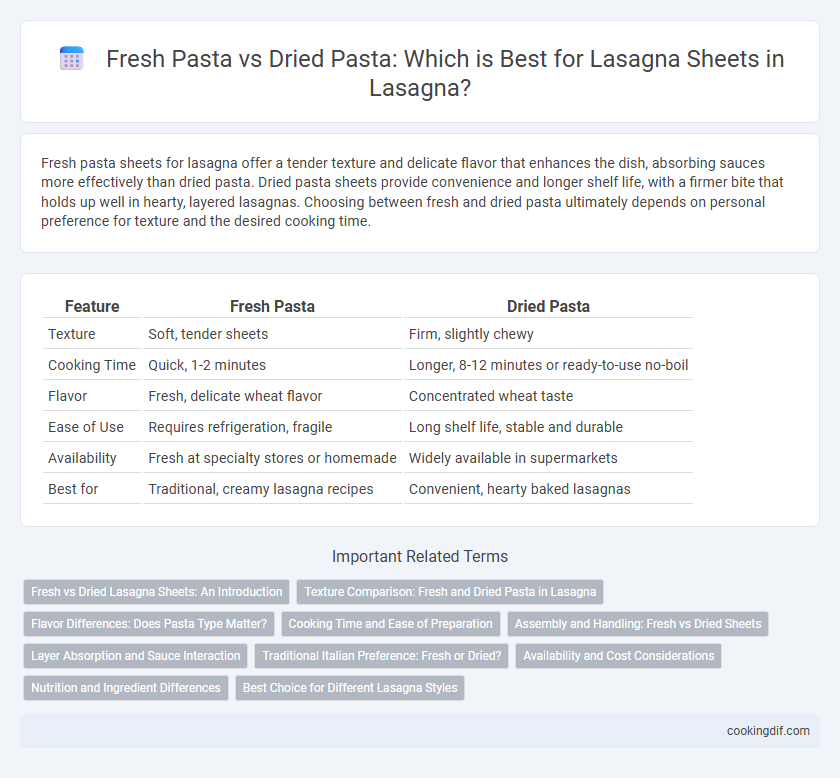Fresh pasta sheets for lasagna offer a tender texture and delicate flavor that enhances the dish, absorbing sauces more effectively than dried pasta. Dried pasta sheets provide convenience and longer shelf life, with a firmer bite that holds up well in hearty, layered lasagnas. Choosing between fresh and dried pasta ultimately depends on personal preference for texture and the desired cooking time.
Table of Comparison
| Feature | Fresh Pasta | Dried Pasta |
|---|---|---|
| Texture | Soft, tender sheets | Firm, slightly chewy |
| Cooking Time | Quick, 1-2 minutes | Longer, 8-12 minutes or ready-to-use no-boil |
| Flavor | Fresh, delicate wheat flavor | Concentrated wheat taste |
| Ease of Use | Requires refrigeration, fragile | Long shelf life, stable and durable |
| Availability | Fresh at specialty stores or homemade | Widely available in supermarkets |
| Best for | Traditional, creamy lasagna recipes | Convenient, hearty baked lasagnas |
Fresh vs Dried Lasagna Sheets: An Introduction
Fresh lasagna sheets offer a tender texture and quicker cooking time, ideal for absorbing rich sauces and blending seamlessly with layers of cheese and fillings. Dried lasagna sheets provide durability and longer shelf life, requiring pre-cooking or sufficient sauce moisture to soften properly during baking. Choosing between fresh and dried sheets affects texture, preparation time, and the overall lasagna experience.
Texture Comparison: Fresh and Dried Pasta in Lasagna
Fresh pasta sheets for lasagna offer a tender, delicate texture that absorbs sauces well, creating a creamy, cohesive bite. Dried pasta sheets, on the other hand, provide a firmer, slightly chewy texture that holds up better during longer baking times without becoming mushy. The choice between fresh and dried pasta significantly affects the final lasagna's mouthfeel, with fresh pasta delivering softness and dried pasta ensuring structural integrity.
Flavor Differences: Does Pasta Type Matter?
Fresh pasta sheets for lasagna offer a delicate, tender texture and a subtle, buttery flavor that enhances rich fillings, while dried pasta provides a firmer bite and a more neutral taste that absorbs sauces effectively. The flavor difference significantly influences the overall lasagna experience, with fresh pasta contributing a more pronounced wheat taste and dried pasta highlighting the filling's ingredients. Choosing between fresh and dried pasta sheets depends on the desired texture and flavor balance in the final dish.
Cooking Time and Ease of Preparation
Fresh pasta sheets for lasagna cook faster, typically within 2 to 4 minutes, and require minimal pre-soaking, making them ideal for quick meal preparation. Dried pasta sheets demand longer cooking times, often 10 to 15 minutes when boiled, or must be softened by soaking before assembly. Choosing fresh pasta reduces overall cooking time and simplifies the layering process, enhancing convenience without sacrificing texture.
Assembly and Handling: Fresh vs Dried Sheets
Fresh pasta sheets for lasagna offer superior pliability and softness, making assembly smoother as they bend easily without cracking or breaking. Dried pasta sheets require pre-cooking or soaking to achieve flexibility, which can complicate handling and increase preparation time. The delicate texture of fresh sheets allows for seamless layering, while dried sheets demand careful attention to avoid brittleness during assembly.
Layer Absorption and Sauce Interaction
Fresh pasta sheets for lasagna offer superior layer absorption due to their higher moisture content, allowing them to soak up sauces more effectively and create a tender texture. Dried pasta, being denser and less porous, absorbs less sauce but maintains a firmer bite that contrasts with rich fillings. Optimal lasagna balances fresh pasta's enhanced sauce interaction with dried pasta's structural integrity to achieve a harmonious layering.
Traditional Italian Preference: Fresh or Dried?
Traditional Italian preference for lasagna sheets often leans towards fresh pasta due to its tender texture and ability to absorb sauces more effectively, enhancing the overall flavor. Fresh pasta, made with flour and eggs, offers a delicate consistency that complements rich fillings and reduces cooking time compared to dried pasta. Dried pasta, typically made with durum wheat semolina, provides a firmer bite and longer shelf life, but is less common in authentic Italian lasagna recipes.
Availability and Cost Considerations
Fresh pasta sheets offer superior texture and flexibility but are typically more expensive and harder to find compared to dried pasta, which is widely available and cost-effective. Dried pasta's extended shelf life and lower price make it a practical choice for everyday lasagna preparation, especially in regions with limited access to fresh pasta. Availability in local markets and budget constraints often influence the decision between fresh and dried pasta sheets for lasagna.
Nutrition and Ingredient Differences
Fresh pasta sheets for lasagna typically contain simple ingredients such as eggs and flour, offering higher protein content and a softer texture with quicker cooking times. Dried pasta sheets are made from durum wheat semolina and water, providing longer shelf life, increased fiber, and a chewier consistency when cooked. Nutritionally, fresh pasta has more moisture and often fewer preservatives, while dried pasta generally contains more carbohydrates and iron due to its concentrated form.
Best Choice for Different Lasagna Styles
Fresh pasta sheets offer a tender texture ideal for traditional, creamy lasagnas that require shorter baking times, as they absorb sauces more effectively. Dried pasta sheets provide a firmer bite and hold up well in baked lasagnas with hearty, chunky fillings or slow-cooked sauces, ensuring structural integrity. Choosing between fresh and dried pasta depends on the desired texture and cooking method, with fresh pasta favored for delicate, moist styles and dried pasta suited for robust, layered casseroles.
Fresh pasta vs Dried pasta for lasagna sheets Infographic

 cookingdif.com
cookingdif.com